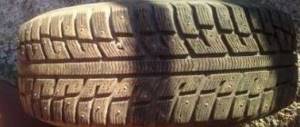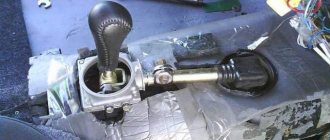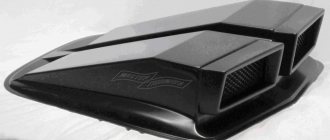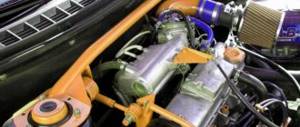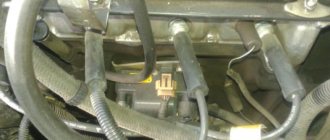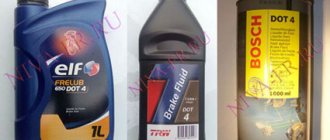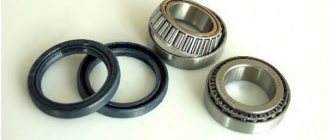| Place | Name | Characteristics in the rating |
| The best inexpensive motor oil |
| 1 | Rosneft Maximum 10W-40 | Popular semi-synthetics |
| 2 | LUKOIL Standard SF/CC 10W-30 | Best mineral oil |
| Best synthetic motor oil |
| 1 | SHELL Helix Ultra Professional AM-L 5W-30 | The choice of professionals |
| 2 | Gazpromneft Premium N 5W-40 | Optimal combination of price and quality |
| 3 | LUKOIL Lux SN/CF 5W-40 | The most affordable synthetics |
| 4 | Castrol Magnatec 5W-40 | Protection from the first second of engine start |
| 5 | GENERAL MOTORS Dexos2 Longlife 5W30 | Original oil for Niva Chevrolet |
| The best gear oil |
| 1 | MANNOL Maxpower 4×4 75W-140 | Universal transmission oil |
| 2 | NESTE Gear S 75W-90 | The best oil for manual transmission |
| 3 | TNK Trans Gipoid Super 75w90 | Affordable domestic transmission |
One of the most popular SUVs in the post-Soviet space is the Chevrolet Niva. Motorists appreciate this model for its accessibility, modern appearance, simple design and maintainability. Many owners maintain their cars themselves, changing engine oil, filters and belts. Therefore, you only have to buy consumables. Lubricants are responsible for the durability of the engine, gearbox and axles. The condition of the rubbing parts depends on their quality. For a domestic SUV, experts recommend purchasing technical fluids with the following set of parameters.
- Motor oil can be used in Russian cars as mineral and semi-synthetic, as well as pure synthetics. It all depends on the climate in a particular region, the load on the SUV, and the frequency of replacement.
- It is best to follow the recommendations of AvtoVAZ, which are indicated in the operating manual. It is not necessary to use original oil; there are worthy competitors that have received approval from leading automakers.
- A good help when choosing will be to study thematic forums or test results from reputable car portals. Someone has managed to identify the advantages or disadvantages of a lubricant from their own experience.
- In a real SUV, transmission units are under heavy load. To prevent the breakdown of a critical gear or differential in a deep puddle, the transmission oil should be changed in a timely manner. When selecting, pay attention to temperature restrictions, this is especially important for residents of the northern regions.
Our review includes the best oils for the Chevrolet Niva. When selecting a lubricant, the following criteria were taken into account:
- appointment;
- technical specifications;
- price;
- expert opinion;
- reviews from car owners.
Mineral lubricants
The most important characteristic that you need to pay attention to when choosing a lubricant is its viscosity. If we are talking about oil, the composition must meet the requirements of international quality standards SAE J306. This type of certification was developed in the USA and is generally accepted today.
When deciding which oil to pour into Niva axles and other components, you need to evaluate the viscosity of the composition. According to the standards, the letter “W” corresponds to this indicator. As a rule, such a symbol is indicated on seasonal compositions. If there is a letter “W” on the package, this indicates that the liquid can be used in winter. In the absence of this symbol, oil may only be used in positive ambient temperatures.
Based on this, many believe that seasonal lubricants are much better. However, this is not quite true. The fact is that when operating any car, you need to change the oil even before it has exhausted its service life. Therefore, you should not be happy if the composition does not change its characteristics throughout the year.
All-season formulations are also on sale. These are the so-called thickened oils. They have the characteristics of both summer and winter lubricants.
And also interesting: Forced engine for the Niva || Forced Niva engine
It is equally important to pay attention to the performance properties of oils. In this case there are also certain standards (APIs). Also, when deciding what kind of oil to pour into the Niva, it is worth considering its composition.
Of course, it is logical to assume that the more natural the composition, the better it will be. This fact is confirmed by the unique properties of oils of this type. When using mineral compounds, contacting parts will deteriorate much more slowly. In addition, the so-called natural compounds have excellent anti-corrosion properties.
There are also those car owners who believe that mineral oils are not able to cope with heavy loads. But it is worth considering that during the internal combustion process, many mineral deposits are formed in the engine, which negatively affect the operation of the power unit. Mineral oils may indeed not be able to cope with serious “build-ups” of burnt particles. However, if we are talking about a car with low mileage, then “mineral water” will be quite enough.
Also, when choosing which oil to pour into the Niva transfer case or car engine, it is worth considering that mineral compounds cannot be used in the cold season. This is explained by the fact that this type of lubricant composition begins to thicken greatly at temperatures below -15 degrees. Because of this, the mechanisms cannot function normally. The use of such oils may result in the power unit having to warm up much longer.
Another disadvantage of mineral compositions is that they sometimes fade. Accordingly, the lubricating characteristics of the liquid decrease. This will lead to the components starting to wear out much faster, and fuel consumption will increase. In rare cases, even damage to the power unit may occur. Thus, it is recommended to use mineral-type compounds only at not very low temperatures and for cars with low mileage.
Leaks and problems
The higher the mileage of the VAZ Niva, the more problems appear, as in principle with any car. Most often this is due to natural wear and tear of the engine, causing oil to burn. Although the manufacturer allows for a small consumption.
Also interesting: WOLF VITALTECH 5W40 oil: Characteristics, articles and reviews
There can be many reasons why an engine eats oil. And in each case they can be individual. But, over the years of the model’s existence, we can talk about the most common places where leaks occur.
If the breather is spewing or throwing oil, or if there is oil in the exhaust manifold, this may indicate a serious problem with the oil rings. In this case, you can try decoking with dimexide. But it is better to use special auto chemicals designed for these purposes.
A leak from under the valve cover may be due to a worn gasket. Sometimes simply replacing the gasket does not solve the problem. Since the cover itself may have significant curvature. Therefore, in some cases it will have to be replaced.
A white emulsion in the engine or on the oil filler cap may indicate condensation. This is a common occurrence when temperatures change from minus to plus, mainly in autumn or spring.
But if the emulsion is also observed on the dipstick, then this is already a sign of more serious problems. Most often we can talk about a broken cylinder block gasket. And in rare cases, a cracked cylinder head may be to blame.
Also, with this problem, you can find oil in the expansion tank. Sometimes, simply replacing the gasket is not enough. It may be necessary to grind the head itself, and this is completely different money for repairs.
All this is general information, which may manifest itself differently on each specific vehicle, since everyone’s operating modes are different. The same applies to leak locations; it is impossible to identify the cause from a distance.
Engine VAZ 21214 1.7l
Changing engine oil is an essential component of proper operation of any car.
Timely replacement of the working fluid and oil filter allows you to maintain the engine in optimal condition, ensuring its long-term and trouble-free operation. Therefore, the owners of this domestically produced SUV have a logical question about what kind of oil to pour into the Niva 21214 with an injector, how much is required, and how to carry out the replacement procedure yourself. Selecting oil for Niva 21214 is not so difficult. But here you need to know some nuances in order to avoid common mistakes. Let's start with the time of year. Not every car owner knows what kind of oil to pour into the engine of his Niva if it’s summer or winter outside. In summer the weather is hot, so passenger car engines get very hot under such conditions.
“Niva 21214” is an all-wheel drive SUV, and its engine warms up even more. That’s why many people make the same mistake, filling in mineral or semi-synthetic oil for the summer. To ensure that the engine runs efficiently and does not overheat, experts recommend using high-quality synthetics.
If the lubricating fluid in the power unit has an insignificant percentage of viscosity, you should not expect the expected effect from it. When the cylinder block heats up, such oils have a consistency similar to ordinary water and their temperature rises rapidly. Therefore, the lubricant will no longer take heat from the engine, performing a cooling function, and will also not be able to create the required pressure. Operating in this mode will lead to rapid jamming of the crankshaft.
Therefore, the manufacturer and experienced car owners themselves advise filling the Niva engine, as well as the Chevy Niva (Chevrolet) engines, with motor oils with a viscosity of 20W40, but not higher than 25W50. These are the optimal viscosity parameters at which the crankshaft can function normally and not create unnecessary load.
- very liquid (otherwise an ice film will form from the cold);
- too thick (otherwise the crankshaft will not be able to rotate when starting a cold engine).
For winter, it is better to fill the engine with oil that meets the viscosity parameters of at least 0W40 and maximum 0W50. By pouring such liquid into the engine in winter, when the temperature drops to a maximum of -40 degrees, the starter can easily cope with cranking. The viscosity is not very high, and even low temperatures will not prevent the engine from starting.
Avoid semi-synthetic oils. Yes, such mixtures can be expensive and have similar characteristics to synthetics. But even the high price and identical labels on the packaging do not allow semi-synthetics to obtain the same properties that synthetic oils have.
The Niva SUV, in all modifications, is very popular in Russian spaces. This is due to good maintainability, low price and excellent maneuverability. To ensure reliable operation, you should undergo all maintenance on time, in particular, change the engine oil.
The VAZ 21214 engine lubrication system is designed to protect against premature wear of moving parts. It completely copes with its task, you just need to follow all the manufacturer’s recommendations.
Changing the engine oil is a regulated maintenance procedure, which is prescribed in the operating instructions. There is nothing complicated about it if you clearly and carefully follow the described action plan.
Our most popular engines are injection and carburetor engines, with a volume of 1.7 and 1.6 liters. The replacement process on these engines, as well as other modifications, will be the same.
To refuel and service a domestic VAZ SUV, you need to know the filling capacities of the VAZ 21213 Niva and its modifications, the VAZ 21214. Some numbers need to be known by heart, for example, the capacity of the tank and engine crankcase. The rest should be written down in a notepad, which is stored in the glove compartment of the cabin.
The VAZ 21214 engine was conceived as the first injection engine for a domestic SUV. The Niva was not particularly popular in the USSR, but was exported to Asia, the UK, Europe, Latin America and the USA. During production since 1994, there have been several improvements and modifications of the internal combustion engine from Euro-0 to Euro-5 (export).
It is believed that the basis of the ICE 21214 was the previous version 21213. In fact, ¾ of the parts in the engine
- the engine layout has changed - an injector instead of a carburetor;
- additional attachments appeared - DPKV, DXX sensor, Bosch MP 7.0 controller;
- crankshaft with a long crank radius of 40 mm, not used in previous AvtoVAZ engines;
- Cylinder head with holes for phase sensor and receiver studs, hydraulic supports for valve levers instead of adjusting bolts.
| Manufacturer | AvtoVAZ |
| Engine brand | 21214 |
| Years of production | 1994 – … |
| Volume | 1690 cm 3 (1.7 l) |
| Power | 59.5 kW (81 hp) |
| Torque moment | 127.5 Nm (at 4000 rpm) |
| Weight | 122 kg |
| Compression ratio | 9,3 |
| Nutrition | injector |
| Motor type | in-line |
| Injection | distributed electronically controlled |
| Ignition | modular |
| Number of cylinders | 4 |
| Location of the first cylinder | TVE |
| Number of valves on each cylinder | 2 |
| Cylinder head material | aluminum alloy |
| Intake manifold | duralumin |
| An exhaust manifold | cast iron or welded steel |
| Camshaft | original cam profile |
| Cylinder block material | cast iron |
| Cylinder diameter | 82 mm |
| Pistons | from 21213 |
| Crankshaft | from 21213 |
| Piston stroke | 80 mm |
| Fuel | AI-92 |
| Environmental standards | Euro-2/3 |
| Fuel consumption | highway – 8.3 l/100 km combined cycle 10.5 l/100 km city – 11.5 l/100 km |
| Oil consumption | maximum 0.7 l/1000 km |
| What kind of oil to pour into the engine by viscosity | 5W30, 5W40, 10W40, 15W40 |
| Which engine oil is best by manufacturer | Liqui Moly, LukOil, Rosneft, Mannol, Mobil |
| Oil for 21214 according to composition | synthetics, semi-synthetics, mineral |
| Engine oil volume | 3.75 l |
| Operating temperature | 95° |
| ICE resource | declared 80,000 km actual 160,000 km |
| Adjustment of valves | hydraulic compensators |
| Cooling system | forced, antifreeze |
| Coolant volume | 7.8 l |
| water pump | with plastic impeller |
| Candles for 21214 | BCPR6ES from NGK or domestic AU17DVRM |
| Spark plug gap | 1.1 mm |
| Timing drive | single row chain |
| Cylinder operating order | 1-3-4-2 |
| Air filter | Nitto, Knecht, Fram, WIX, Hengst |
| Oil filter | with check valve |
| Flywheel | from 21213 with clutch bore diameter 200 mm or 215 mm |
| Flywheel mounting bolts | M12x1.25 mm, length 26 mm |
| Valve stem seals | manufacturer Goetze, light inlets, dark exhausts |
| Compression | from 12 bar, difference in adjacent cylinders maximum 1 bar |
| XX speed | 800 – 850 min -1 |
| Tightening force of threaded connections | spark plug – 31 – 39 Nm flywheel – 62 – 87 Nm clutch bolt – 19 – 30 Nm bearing cap – 68 – 84 Nm (main) and 43 – 53 (rod) cylinder head – three stages 20 Nm, 69 – 85 Nm 90° 90° |
Initially, the 21214 engine was developed for distributed injection, that is, for an injector. It was planned to ensure an environmentally friendly standard, which was carried out successfully - during the finalization process, the internal combustion engines had Euro-2 - Euro-4, and for the export versions of Niva and Nadezhda, even Euro-5.
The main feature of 21214 was the factory boost:
- injector instead of carburetor;
- modified cylinder head (hydraulic pushers);
In turn, this required improvement of other designs:
- the volume of engine oil has increased, the pump sprocket now has 30 teeth to increase its performance;
- the double-row chain is replaced by a roller-type single-row modification to drive attachments and the timing camshaft;
- The camshaft cams have changed shape.
Upgraded chain tension system:
- the spring creates pre-tension when the engine is off;
- After starting, pressure is created in the system, the tension is regulated by hydraulics.
The manufacturer has provided additional tuning with your own hands due to the 50 hp potential built into the design. With. Overhauling the simplest internal combustion engine design does not cause any problems, including in a garage on your own.
To work you will need:
- Oil.
- New oil filter.
- To drain the waste - a container.
- Flashlight.
- Wrenches.
- Puller for removing the filter.
Operation procedure:
- The car is mounted on an overpass and can be lifted on a lift.
- The dipstick is pulled out from the filler neck.
- The mudguard that protects the engine is removed.
- A container is placed to drain the waste. For Niva, its volume must be at least three liters.
- The drain plug is unscrewed. Its location is shown in the photo.
Location of the VAZ 2121 engine drain plug
- Oil is drained.
- The filter is removed. If necessary, a puller is used.
Removing the oil filter
- A little fresh oil is poured into the new filter.
- The sealing rubber of the filter is lubricated with the same composition.
- The device is installed in place. It twists about half a turn after the rubber band touches the cylinder block. You can see how to do this correctly in the video.
- Oil is poured into the engine through the neck.
- Check the level of the filled liquid using the marks.
- The engine starts and runs until the oil pressure light goes out.
- If necessary, lubricating fluid must be added.
- Check the tightness of the filter installation.
Also interesting: To chip or not to chip a car engine
Lukoil Lux 10W-40
The product is produced by the Russian company LUKOIL and is known not only in the domestic market, but also abroad.
The liquid in question is semi-synthetic. Lukoil Lux 10W-40 can be used at any time of the year and under any conditions. It is perfect for gasoline and diesel engines of modern cars, both domestic and foreign.
The advantages of this oil include the following:
- retains its working qualities for a long time;
- remains stable even with sharp fluctuations in ambient temperature;
- has a low viscosity, making it easy to start the engine in winter;
- has high lubricating properties, allowing you to reliably protect the vehicle’s power plant from wear;
- counteracts corrosive processes;
Many, when choosing which oil to pour into the Niva, give preference to this particular composition. The lubricating fluid of this brand meets all the necessary requirements. Car owners trust the quality of these compounds, since this manufacturer has long established itself in the market.
"Lukoil Lux 10W-40" has a positive effect on the power unit and helps conserve energy. Many noted that these compounds help reduce fuel consumption. According to tests, this oil performs well in various extreme conditions.
It is a fairly high-quality Russian version that fully meets the standards stated on the packaging. This product has a positive effect on the car’s engine and has been able to establish itself at the highest level in the market. Lukoil 10v-30 is capable of saving energy (due to this option, reduced gasoline consumption is guaranteed). The motor lubricant of the series has proven itself to be beneficial when working in the most dangerous conditions for the engine.
- Luxury Hit and Best, which is rarer on the domestic market, are also effective options. If you are on the side of the latest advances in the chemical industry and want only the most modern oil for your Niva, which has won numerous awards, then you should pay attention to lubricants from. The company's lubricants contain molybdenum, which is capable of distinguishing this oil from equal ones in cost. Thanks to this substance, the engine is able to operate much more stably under any conditions, and the “eating” of gasoline by the car is reduced by 4 percent. If the Chevrolet has a good mileage, then replacing the lubricant with a newer one in the form of “Dolphin” is a good choice.
- Rosneft Premium motor oil is the choice for those who want to support the Russian manufacturer. This product can effectively compete with many brands - the lubricant has the best properties in cold weather and has proven itself well in hot weather, thanks to new additives.
- Replacing your current motor lubricant on Niva with Rosneft Premium series is appropriate even in the most dangerous weather conditions. The product is not afraid of strong temperature changes. The “consumable” almost does not emit harmful vapors and does not evaporate into the atmosphere, therefore, replacing the lubricant is postponed for 2-3 thousand kilometers.
- Shell Helix. Shell is one of the leading companies producing automotive lubricants. If you ask hundreds of car enthusiasts their opinion about Shell Helix, most of them will confidently say that they try to buy Shell oils, as opposed to other oils. The production technologies are classified, but let's just say that the line of products from Shell is definitely suitable for use in the Chevrolet Niva engine.
Also interesting: Overheating of VAZ-21213 and VAZ-21214 engines on Lada Niva and Lada 4x4
What kind of lubricant to pour into the Chevrolet Niva engine is something only the car enthusiast can choose. The most important thing is that the oil change is done according to plan and without time delays.
Now let’s try to understand how to correctly pour lubricant into the engine of a Niva car and what we need for this.
Changing the oil in a Niva car is almost no different from changing the oil in another car. You can go through all the replacement stages yourself, without contacting specialists.


